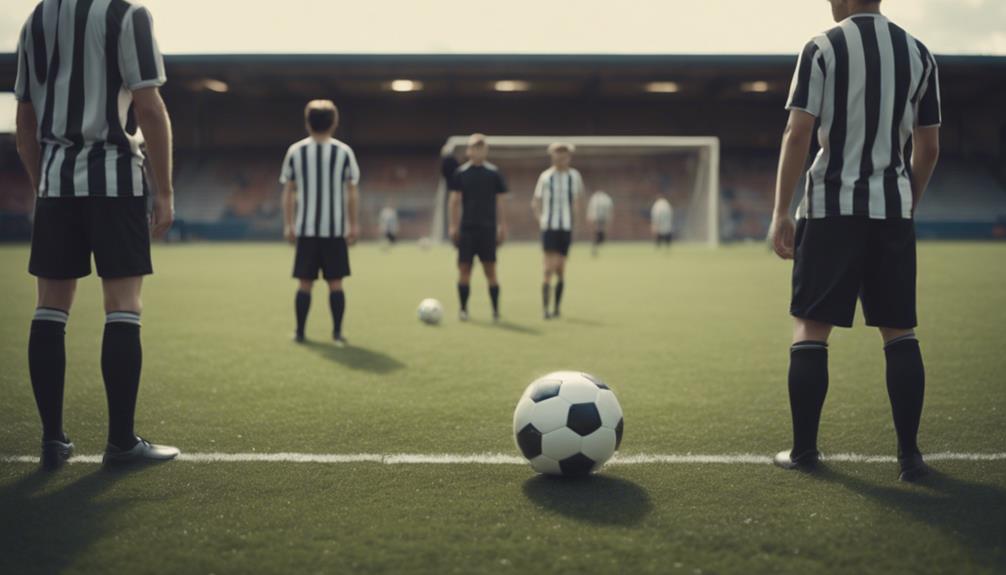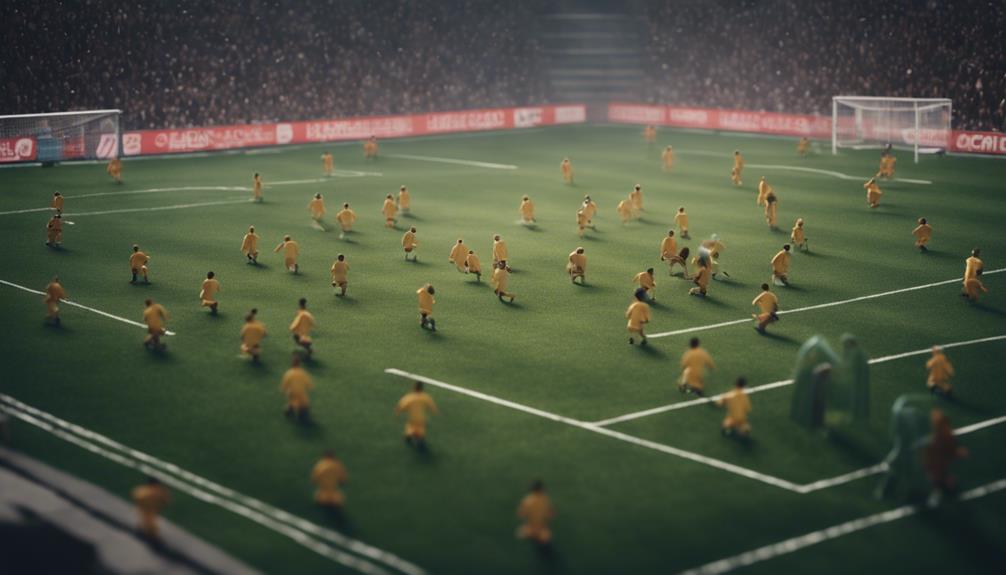
How to Play Football Soccer: A Beginner’s Guide
July 18, 2024To start playing football soccer as a beginner, grasp the basic rules, field sizes, referee signals, terminology, gear, and game organization. Understand the roles, strategy, and key skills. Equipped with this knowledge, you'll build a strong foundation in the sport and be ready to hit the pitch confidently.
Basic Rules of Soccer
To understand how to play football soccer effectively, you must first grasp the basic rules of the game. Soccer matches consist of two 45-minute halves, with stoppage time added for breaks in play. Referees play an important role in enforcing rules and penalizing fouls. They use yellow cards as warnings and red cards for more serious infractions, resulting in player ejections.
Key rules to understand include offside violations, different types of fouls, and the consequences of receiving yellow and red cards. Offside occurs when an attacking player receives the ball behind the last defender. Fouls in the penalty area can lead to penalty kicks, a direct shot at goal from the penalty spot.
Teams are allowed up to three substitutions during a game, providing an opportunity for fresh legs and tactical changes.
Understanding these rules is necessary to navigate the game effectively as a player or fan.
Soccer Field Dimensions
Soccer field dimensions vary but typically range between 100 to 130 yards in length and 50 to 100 yards in width. The standard size for international matches falls around 110-120 yards long and 70-80 yards wide.
Depending on the age group and level of play, soccer fields must meet both minimum and maximum size requirements to guarantee fair gameplay.
Here are some key points regarding soccer field dimensions:
- Flexibility: Field dimensions can vary based on age group and level of play.
- Regulation Size: The standard size for international matches is around 110-120 yards long and 70-80 yards wide.
- Minimum and Maximum Requirements: Fields must meet specific size criteria to ensure fair play.
- Adaptability: NFL stadiums can often accommodate regulation soccer fields due to their size and layout.
Referee Signals and Calls

Referees in football soccer utilize distinct hand signals and calls to effectively communicate decisions during a match.
When a player commits a foul, the referee may opt to caution them by pulling out a yellow card, signaling unsporting behavior. For more serious offenses, the referee will brandish a red card, indicating that the player is expelled from the game.
The whistle blows serve as vital indicators, signaling the start, stop, or restart of play, with different sequences conveying various situations.
Additionally, referees use a flag signal to highlight offside infractions, raising the flag to indicate the position of the offending player in relation to the last defender.
Referees also make a circular motion above their heads to signify an advantage, allowing play to continue even after a foul has been committed.
Familiarizing yourself with these referee signals and calls will enhance your understanding of the game and its rules.
Key Soccer Terms to Know
You're about to learn some vital soccer terms that will help you better understand the game.
From essential vocabulary to common lingo, these terms are the building blocks of soccer knowledge.
Essential Soccer Vocabulary
Understanding key soccer terms is essential for grasping the nuances of the game. Here are some essential soccer vocabulary terms to enhance your knowledge:
- Offside: A player is in an offside position if they're nearer to the opponent's goal line than both the ball and the second-to-last defender.
- Dribble: Technique of moving the ball past opponents while maintaining control, essential for advancing the ball up the field.
- Penalty Kick: Awarded after a foul inside the penalty area, allowing for a direct shot on goal from the penalty spot.
- Yellow Card: Caution given by the referee for unsporting behavior, serving as a warning to players to avoid further misconduct.
Common Soccer Lingo
Get a grasp of the common soccer lingo with these key terms to know. In soccer, the game revolves around the soccer ball, but there are specific terms and actions that players and fans should be familiar with.
A yellow card is a caution given by the referee to a player for unsporting behavior. On the other hand, a red card means immediate expulsion from the game.
Penalty kicks are awarded after certain fouls inside the penalty box, giving a player a direct shot at goal.
Throw-ins occur when the ball goes out of play over the touchlines, while goal kicks restart play when the attacking team touched it last before it went out over the goal line.
Corner kicks are awarded when the defending team clears the ball out of bounds over their own goal line. Understanding these key terms will enhance your knowledge and enjoyment of the game.
Soccer Terminology Basics
Familiarize yourself with essential soccer terminology by grasping key soccer terms important for understanding the game. When starting to learn about soccer, knowing these basic rules and terms will enhance your enjoyment and comprehension of matches. Here are some key soccer terms to get you started:
- Offside: It's important to understand the offside rule, which determines if a player is in an offside position relative to the ball and the second-to-last defender.
- Dribble: Dribbling is a fundamental soccer skill where players maneuver the ball past opponents while maintaining control to advance up the field.
- Penalty Kick: A penalty kick is awarded to the attacking team after a foul inside the penalty area, providing them with a direct shot at the goal from the penalty spot.
- Yellow Card: The referee issues a yellow card as a caution for unsporting behavior, serving as a warning to the player for their actions.
Essential Soccer Equipment

You need to have the right gear to play soccer effectively. Jerseys, shorts, socks, cleats, and shin guards are essential for your safety and performance on the field.
Understanding the equipment needed will help you prepare for a successful game.
Gear for Players
Essential soccer gear for players includes jerseys, shorts, socks, cleats, and shin guards to guarantee safety and comfort during matches. Properly fitted cleats provide traction on the field, helping players maintain stability and agility during play.
Shin guards protect the lower legs from impact and are crucial for player safety in most soccer leagues. High-quality jerseys are designed for breathability and moisture-wicking to keep players cool and comfortable during matches.
Socks are an important part of soccer gear, providing cushioning and support while also helping to hold shin guards in place. To excel in soccer, make sure you have the essential gear – from jerseys that keep you dry to cleats that provide grip.
Don't forget your shin guards; they're essential for protecting your legs. Finally, comfortable socks will help you stay focused on the game without distractions. Prioritize safety and comfort with the right soccer equipment.
Field Equipment Needed
One key piece of field equipment needed for playing soccer is the soccer ball, available in various sizes to suit different age groups and skill levels. As players progress in age and skill, they move from smaller to regulation size balls.
Modern soccer balls are typically made of lightweight plastic materials, a far cry from the older leather balls used in the past. In addition to the soccer ball, essential equipment includes cleats, shin guards, a jersey, shorts, and socks. Cleats provide traction on the field, while shin guards protect players from potential injuries during tackles.
A jersey, shorts, and socks complete the uniform, allowing players to move comfortably and identify teammates and opponents easily. It's important to make sure you have the right equipment before stepping onto the field to play.
You can find proper soccer gear at specialized stores like SOCCER.COM. Make sure your equipment fits well and is in good condition to enhance your performance and safety during matches.
Soccer Positions Explained
Understanding the roles of different soccer positions is essential for grasping the dynamics of the game. Each position on the field plays a pivotal role in the team's overall strategy:
- Goalkeeper: The goalkeeper is responsible for protecting the goal and preventing the opposing team from scoring. They're the last line of defense.
- Defenders: Defenders focus on stopping the opposing team's attacks and protecting the goal area. They work to regain possession and stop the opposition from advancing.
- Midfielders: Midfielders play an important role in controlling the flow of the game. They switch between defense and offense, linking play between the different areas of the field.
- Forwards: Forwards are tasked with scoring goals and putting pressure on the opposing team's defense. They're key players in creating scoring opportunities and finishing plays.
Each position has specific responsibilities that contribute to the team's overall strategy and success on the field.
Soccer Game Structure Overview

So, let's talk about how a soccer game is put together.
Understanding the basic game rules, field positions, and match duration is key to grasping the game's structure.
It sets the stage for an exciting and strategic play that keeps you on your toes throughout the match.
Basic Game Rules
In soccer, the basic game rules outline the structure of matches, including the duration of play and the role of the referee in maintaining order on the field.
Soccer games consist of two 45-minute halves separated by a short break for regrouping. Referees have the authority to add stoppage time to the match to make up for any time lost during the game, which often extends beyond the 90-minute mark.
During the game, the referee can issue yellow cards as warnings for misconduct and red cards for serious offenses, resulting in player ejection. A red card means that the penalized team must play with one player down, significantly impacting their strategy and gameplay.
Field Positions
Field positions in soccer dictate the strategic placement of players on the field, each with specific roles essential to the team's overall performance. The field positions include defenders, midfielders, forwards, and the goalkeeper, who all have distinct responsibilities.
Defenders primarily focus on protecting the goal and thwarting the opponent's attacks, forming a solid line of defense alongside the goalkeeper. Midfielders act as the link between defense and offense, controlling the tempo of the game and providing support to both ends of the field. Forwards are tasked with scoring goals, making strategic runs, and pressuring the opposing team's defense to create scoring opportunities.
Understanding these positions and their roles is vital for a well-rounded team strategy, as each player contributes uniquely to the team's success on the pitch. Mastering the coordination and cooperation among these positions is key to achieving victory in a game of soccer.
Match Duration
To grasp the overall structure of a soccer game, understanding the match duration is essential. Soccer matches are divided into two halves, each lasting 45 minutes, resulting in a total playing time of 90 minutes.
However, the actual playing time may exceed this duration due to stoppage time. Stoppage time is vital as it accommodates interruptions in the game and guarantees fairness in the total playing time.
Referees are responsible for calculating and adding stoppage time at the end of each half based on various factors such as injuries, substitutions, and time-wasting tactics.
Players must be aware that the game continues until the referee blows the final whistle, even if it extends beyond the initial 90 minutes.
Understanding the concept of stoppage time is essential for players and spectators to comprehend the full duration and dynamics of a soccer match.
Basic Soccer Skills Training
Develop your soccer skills by focusing on practicing essential techniques such as dribbling, passing, shooting, and ball control. These basic skills are important for players to excel on the field.
Dribbling involves maneuvering the ball skillfully past opponents, while passing requires precision to move the ball to teammates effectively. Shooting demands accuracy and power to score goals, and mastering ball control skills guarantees you can handle the ball adeptly in various situations.
Additionally, working on positional awareness is essential. Understand the roles and responsibilities associated with different positions on the field. This knowledge helps you make better decisions during gameplay and contributes to overall team success.
Basic soccer skills training also includes drills for defensive techniques like marking opponents and tackling. Agility, speed, and coordination are essential attributes to improve your performance on the field.
Soccer Match Strategies

Improve your soccer game by strategically planning your approach to matches through effective formations and tactical decisions. When considering match strategies, remember these key points:
- Player Positioning: Implementing formations like 4-4-2 or 4-3-3 optimizes player positioning on the field, enhancing team coordination and overall performance.
- Team Strategy: Utilize tactics such as high pressing, counter-attacking, or possession-based play to shape your team's approach and respond effectively to different game situations.
- Opponent Analysis: Understanding your opponents' strengths and weaknesses is vital in devising specific match strategies to exploit their vulnerabilities and gain a competitive edge.
- Communication: Clear communication among teammates, defining roles and responsibilities, and making quick decisions are essential for executing successful match strategies in soccer. Effective communication enhances teamwork and ensures everyone is on the same page during the game.
Joining a Soccer Team
Consider joining a soccer team to enhance your skills and experience more competitive play in a structured environment. Playing for a team provides you with the opportunity to refine your abilities through regular training sessions and matches. When on a team, you'll have specific roles and positions to fulfill, contributing to the overall strategy and success of the group.
Remember, the objective of the game is to score goals by getting the ball into the opponent's goal line using any part of your body except your arms and hands. Additionally, familiarize yourself with soccer rules such as when a player touches the ball, how to take a free kick, and the number of substitutions per game.
Joining a team can also open doors to higher levels of competition, such as playing for a school, college, or even pursuing a career in professional soccer. Embrace the camaraderie, challenges, and growth that come with being part of a soccer team.
Conclusion
Congratulations on taking the first step towards becoming a soccer player!
Did you know that soccer is the most popular sport in the world, with an estimated 4 billion fans worldwide?
Keep practicing your skills, learning the rules, and staying committed to your training.
Before you know it, you'll be out on the field scoring goals and having a blast playing the beautiful game of soccer.
Good luck and have fun!


